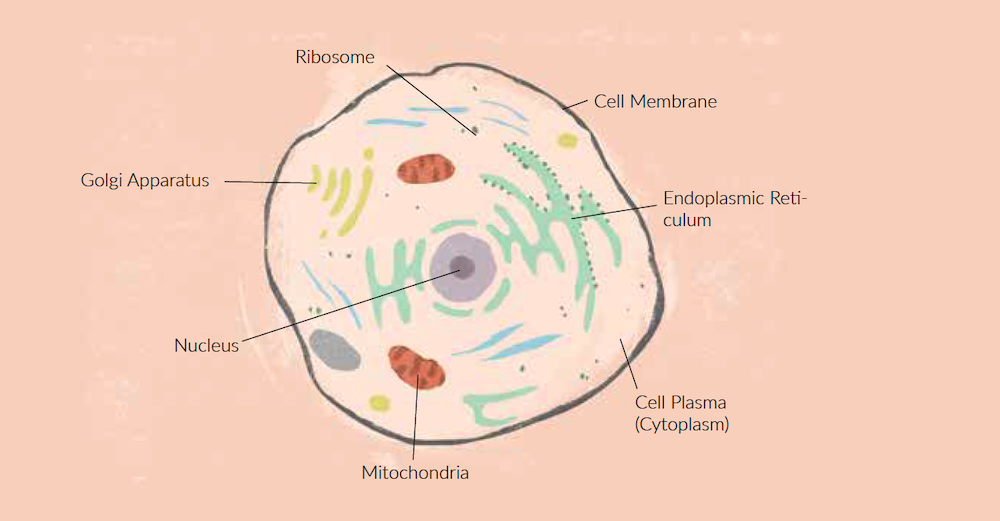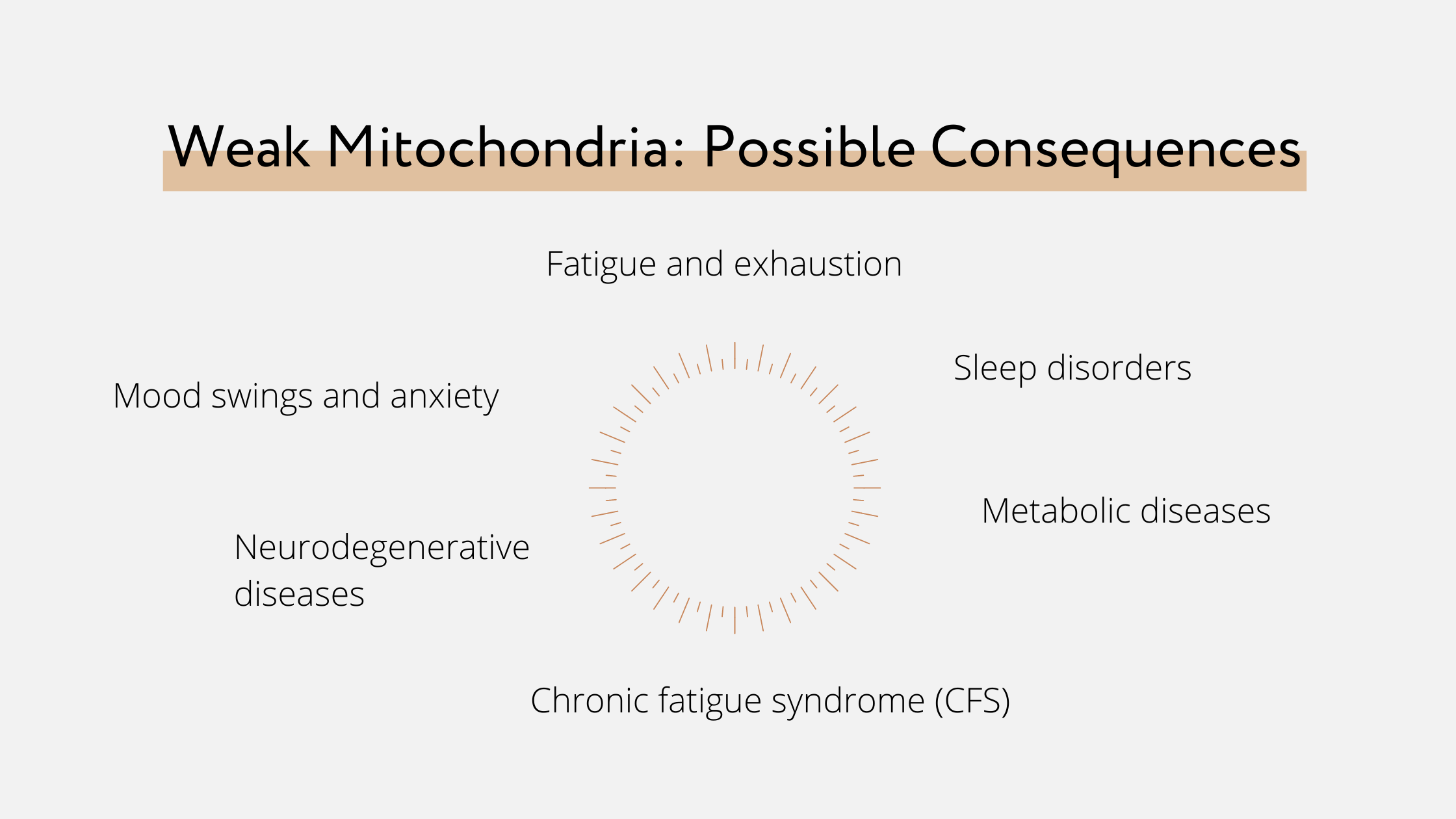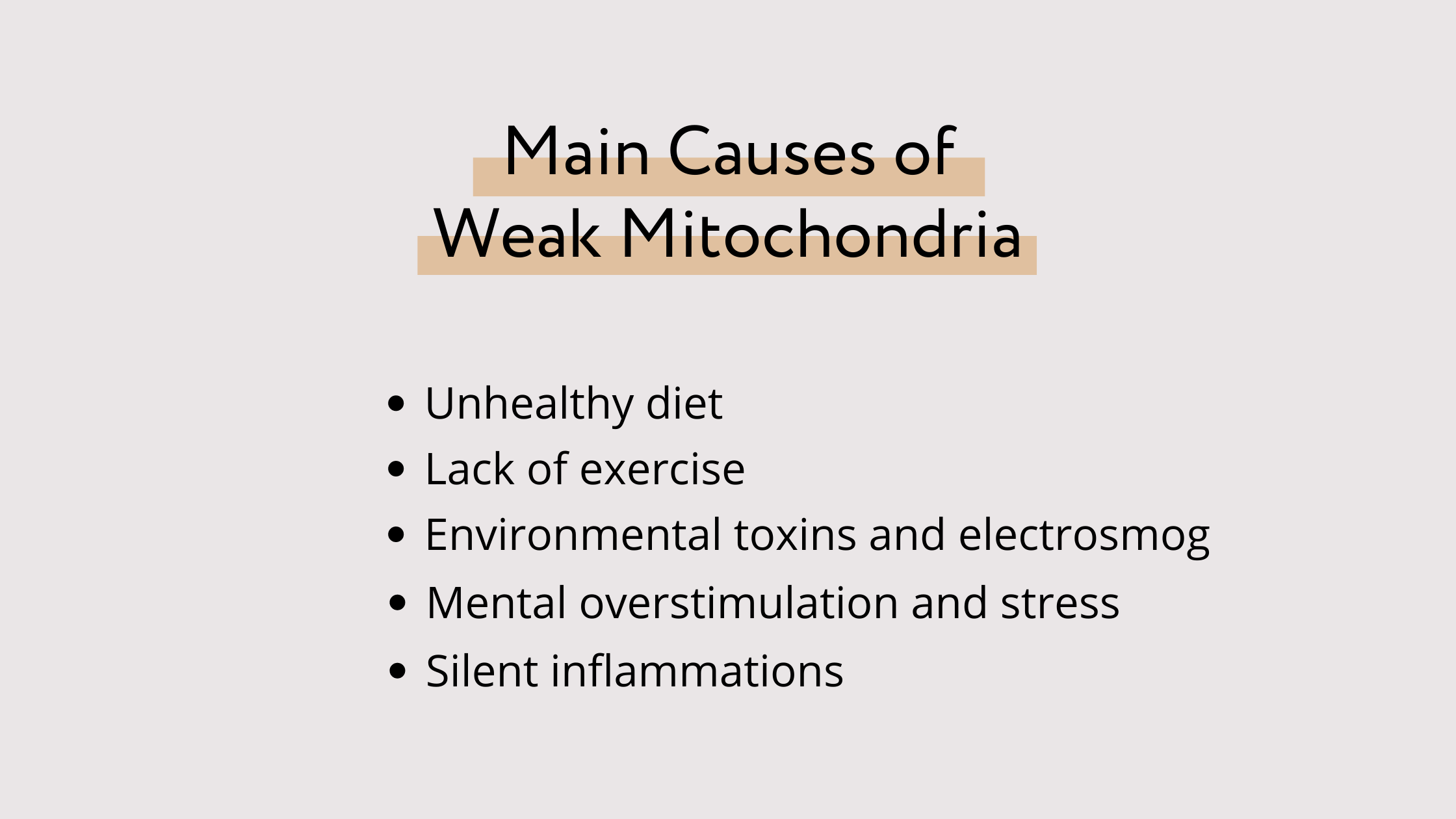A lot of people complain about having fatigue and chronic exhaustion: weak mitochondria can actually be a reason for this. The topic of cell organelles is becoming increasingly important in the field of medicine and naturopathy, because without well-functioning mitochondria, we lose both vitality and efficiency.
What Are Mitochondria?
Mitochondria are tiny organelles in our cells. Organelles can be thought of as the “working squads” within the cell that perform all kinds of very specific tasks.
The most important cell organelles are:
- The mitochondria
- The endoplasmic reticulum
- The ribosomes
- The Golgi apparatus

Figure: the human cell
Mitochondria are found in every cell of the body, with the exception of red blood cells. Depending on how much energy is required, a single body cell can house between 1000 and 7000 mitochondria. In cells that have a particularly fast metabolism, like muscle, sensory, and nerve cells, there’s an accordingly higher number of mitochondria. Cells with lower activity, like cartilage cells, have fewer mitochondria.
It’s actually assumed that mitochondria were originally independent bacteria, and that in the course of evolution they entered into a symbiosis with cells of higher life forms. Even today, mitochondria exhibit bacterial characteristics. They have a double membrane and their own DNA, and they reproduce by division
What Are the Tasks of Mitochondria?
The most important task of mitochondria is the production of energy. Therefore, they are also called the power plants of the cells. Instead of producing electricity, like real power plants, mitochondria produce ATP (adenosine triphosphate). To do this, quadrillions of mitochondria continuously take up glucose, which is completely broken down into carbon dioxide and water with the help of oxygen. This process, known as cellular respiration, involves very complex processes: glycolysis, the citrate cycle, and the respiratory chain
The overall balance of cellular respiration:
Glucose + oxygen = Carbon dioxide + water + ATP ( energie)
C6H12O6 + 6 O2 = 6 CO2 + 6 H2O + ATP
At the end of the degradation pathway, one of the three phosphate residues splits off from the adenosine triphosphate (ATP), releasing energy that is converted into work like heat and muscle power. The energy-rich ATP is then turned into the energy-poor ADP. Since our cells need more energy very quickly, energy-degrading and energy-building processes alternate within a short period of time. In the process, ADP is regenerated back into ATP.
Mitochondria Produce Life Energy
Representatives of bioenergetics also define ATP as “universal life energy,” Chinese Qi. In Qi Gong, a Chinese form of meditation and movement, the goal is for this energy to be increased and cultivated.
Christian Opitz provides an explanation in his book “Mitochondria.” Here he echoes the accounts of the American biochemist Lubert Stryer. He describes that during cellular respiration, electrons are released and accelerated when glucose or fatty acids decay. They generate a strong electromagnetic field that energetically charges the carrier of life energy, ATP. This view transcends the purely chemical and analytical standpoint, and opens up an understanding of what “universal life energy” really is.
Other Tasks of the Mitochondria
In addition to energy production, mitochondria perform other important tasks and basic cellular functions:
- They contain their own DNA in what’s referred to as the “matrix.” This means they are also involved in genetics.
- They store calcium. The calcium serves as a messenger in signal transmission within the cell.
- They regulate metabolic processes within the cell.
- They control cell communication, cell division, and the breakdown of damaged cells.
Mitochondria: Constant Build-Up and Breakdown
Like all cells and components of our body, mitochondria are in a constant state of breakdown and construction. They multiply, they grow, they can be damaged, and they can be dismantled. The body itself can regulate how many mitochondria a cell has. The quantity adapts to the body’s respective energy consumption.
For example, the more we exercise, the more mitochondria we build in our muscle cells. The less physically active we are, the less energy we produce in the muscle cells and the fewer mitochondria we need – as a result each movement is correspondingly more strenuous. You will also learn how to strengthen your mitochondria later in the article.
Why Is the Health of Mitochondria So Important?
Only when we know the tasks of the mitochondria does it become clear how important the mitochondria truly are. We realize that in addition to energy production, they are the basis of all cellular functions, that ist:
Without the work of the mitochondria nothing runs in our body.
So for the sake of our health we need to support the mitochondria for them to function properly. This is the only way for them to provide us with the energy we need every single day, and for the cells to carry out their metabolic processes. Damaged or weak mitochondria limit our physical and mental performance and can be the foundation of many other physical problems.
To give some examples, if the liver cells aren’t well equipped, the organ won’t be able to detoxify properly. If the muscle cells are affected, movement becomes more difficult. And if the nerve cells don’t have strong mitochondria, concentration and memory will decline.
Mitochondrial Medicine for Healthy Cellular Power Plants
Since the importance of mitochondria is so key for our health, an entirely new branch has developed in biological-naturopathic medicine..
Let’s distinguish between the two forms of mitochondrial disorders:
- What’s commonly referred to as “primary mitochondrial disease:” This is due to genetic defects and can cause severe symptoms and diseases as early as during childhood..
- Acquired mitochondrial dysfunction: This mitochondrial disorder can manifest as exhaustion, allergies, or neurodegenerative disease, and it’s now known that this form is often based on a lack of energy in the mitochondria.
Recognize dysfunctions and identify symptoms
Mitochondrial medicine aims to detect and treat mitochondrial dysfunction. Whether or not someone may have a mitochondrial disorder can be determined by a blood test.
Weak mitochondria no longer carry out the respiratory chain properly and can no longer meet the current energy needs of our cells. Instead of energy, they produce oxidative stress, resulting in free radicals, which in turn attack healthy mitochondria.
Long-standing research results make it clear how essential mitochondria are for vitality and performance. Weak mitochondria can manifest themselves in weakness and fatigue, but can also play a major role in chronic and inflammatory diseases(1).
Possible consequences of weak mitochondria:
- Fatigue and exhaustion
- Sleep disorders
- Chronic fatigue syndrome (CFS)
- Mood swings and anxiety
- Burnout and depression
- Neurodegenerative diseases (Alzheimer’s, multiple sclerosis, Parkinson’s)
- Metabolic diseases (diabetes, thyroid problems)
- Cardiovascular diseases

Causes for Weak Mitochondria
The causes of weak mitochondria can essentially be divided into 5 groups:
- Unhealthy diet
- Lack of exercise
- Mental overstimulation and stress
- Environmental toxins and electrosmog
- Silent inflammation
Unhealthy Diet
Comparing the eating habits of the average society with those who age in a healthy way shows very clearly that lifestyle diseases and weak mitochondria are linked to the consumption of industrial food.
Longevity studies have shown that people who age healthily consume mainly naturally produced and less processed foods. Our bodies are biologically adapted to foods as they exist in nature, and as they have been consumed for many thousands of years.
Today, the modern food industry gives us food that contains too many harmful components:
- Animal products from factory farming
- Refined sugar
- Trans fats
- Hybrid fruits
- Too much salt
- Too much gluten
- Preservatives, flavorings, and more
As a rule, industrially processed products have a very high energy content (i.e. they are high in calories) and at the same time contain barely any nutrients. Some products can be downright harmful because of industrial processing. For instance, the trans fatty acids produced by hardening unsaturated fatty acids are so harmful to our health that their use in foods is actually banned in a number of countries.
Oxidative and nitrosative stress
Oxidative stressis a metabolic condition involving an imbalance between free radicals and radical scavengers (antioxidants).
Free radicals are highly reactive molecules because they don’t have an electron in their chemical structure. As a result, they try to snatch an electron from other molecules in order to become stable and complete again.
An excessive concentration of free radicals, which could come from electromagnetic radiation, an unhealthy diet, or environmental stress, damages the mitochondria. The result is a decrease in energy production (ATP), along with the physical harm mentioned above.
Similar to oxidative stress, in which oxygen free radicals drive oxidation-promoting processes,bei nitrosative stress results in the release of the radical nitric oxide (NO), a reactive compound that’s broken down into nitrate and nitrite.
Nitric oxide is a part of cell metabolism and is also involved in immune defense, in small amounts. Environmental toxins like fertilizers consisting of nitrate-phosphate-potassium, but also cured sausages, cheese, or even leafy vegetables from heated greenhouses can cause increased NO production.
Are you interested in gaining a comprehensive understanding of the health benefits of a plant-based diet? Download the curriculum for our Holistic Nutrition Coach training program.
Lack of exercise
Exercise is particularly important for our mitochondria because it stimulates their reproduction. More mitochondria have more capacity to produce energy.
A good balance of athletic activities is especially conducive to this. Through regular, moderate training, the body adapts to these challenges by increasing its own number of mitochondria, among other things. Energy is produced by using oxygen in the mitochondria, without forming any lactate.
Even short and intensive training units of a maximum of 60 seconds, like sprints or weight training exercises, can still be accomplished by the body in this way.
On the other hand, long periods of intense exercise, and approaching athletic training with too much ambition, exhaust the mitochondria instead of stimulating them to multiply. In addition to the exhaustion, this leads to anaerobic metabolism (ATP production without oxygen) and hyperacidity due to incomplete glucose breakdown and lactate formation. Anaerobic metabolism happens outside the mitochondria in the interior of the cell, which is called the cytoplasm, and has quite a stressful effect on the mitochondria.
Mental overstimulation and stress
Life in the digital age has moved a long way away from life that was originally close to nature, and as a result this presents our bodies with a lot of challenges. We’re exposed to so much more information while using our smartphones and laptops than what is actually beneficial to us. Without enough periods of relaxation, our mitochondria gradually start becoming exhausted, which in turn manifests itself in our own physical exhaustion and fatigue.
A constant amount of stress in our professional and private lives, as well as too many demands on ourselves in general, also leads to the body becoming overstrained. This especially is a challenge to the adrenal glands, which then run at full speed until they get tired or even completely exhausted. One of the main factors in this scenario is our exhausted mitochondria.
Environmental toxins and electrosmog
Today we are exposed to thousands of chemical substances that didn’t exist 100 years ago. Some examples of these are pesticides, fungicides, herbicides, drugs, hormone-like substances, and also heavy metals like mercury, lead, or the lightweight metal aluminum. And the interactions of these chemicals with each other should not be underestimated.
Ayurvedic physician Dr. Switzer pays special attention to a weedkiller called glyphosate, also known as Roundup. It’s the most widely used herbicide in the world and can now be detected in almost all conventionally produced foods. Extensive research shows that glyphosate has hormonal and antibiotic effects on both humans and animals, and causes massive blockages at the cellular level.
We come across electromagnetic fields everywhere. However, we have plenty of control over our personal use of electrical appliances, WIFI routers, and cell phones. Everything should be completely switched off when possible – especially at night – so that the mitochondria, which are particularly sensitive to electromagnetic radiation, are able to recover.
Silent inflammations
Silent inflammations are often able to go unnoticed for a long time, as the name suggests. As a result, the immune system is in constant use, which can lead to chronic diseases. The mitochondria, the power plants of our cells, can also be affected by this.

How Can We Strengthen Weak Mitochondria?
The good news is that weak mitochondria can recover and regenerate.
The Mitochondria-Friendly Lifestyle
First of all, it’s important to relieve the mitochondria by limiting or avoiding any factors that weaken the mitochondria as much as possible..
Factors to avoid are:
- Long periods on the cell phone, laptop, or PC
- Mental and physical stress
- Polluted food (heavy metals, pesticides, etc.)
- Heavily processed foods, for the reasons mentioned above
Valuable factors are:
- Getting enough exercise, preferably in the fresh air, as well as strength training. This promotes oxygenation of the cell and mitochondrial proliferation.
- Walking barefoot in a meadow increases the negative electrons in our body, which counteracts oxidative stress.
- Getting enough sleep is incredibly valuable for the regeneration of the mitochondria.
- Cold training, in the form of cold showers or ice baths, stimulates mitochondrial activity and respiration in muscle cells.
Mitochondria-Friendly Diet
In order to strengthen weak mitochondria, we have a wide range of options when it comes to nutrition.
The nutrient-rich diet
Undoubtedly, a raw vegan diet allows us to eat in a way that gets as many nutrients to our cells as possible, and as few unhelpful substances as possible.
Fresh plant foods have a wealth of nutrients in a natural combination of active ingredients. This makes them extremely rich in minerals, vitamins, and phytonutrients. The enzymes, biophotons, chlorophyll, dietary fiber and antioxidants they contain are also incredibly valuable. The goal isn’t necessarily a 100% raw food diet, but a diet of mostly fresh vegetables that’s also alkaline-forming.
Dr. John Switzer has had particularly good experience with supplementing his own diet with wild herbs and fermented juices. The appeal of wild herbs is their high content of phytonutrients, and the antioxidant and antibacterial effect that this creates. Fermented juices are very rich in enzymes and probiotics. This means they have an invigorating and intestine-friendly effect, which also is good for the mitochondria. In addition, there are studies that show that short-chain fatty acids, which are produced by intestinal bacteria when eating high-fiber foods, improve mitochondrial function (1).
Christian Opitz points out that healthy fats play an essential role in mitochondrial health, especially the medium-chain saturated fatty acids in coconut products. Unlike long-chain fatty acids, these can enter the mitochondria directly, where they can be utilized as energy sources, without being transported by L-carnitin.
Intermittent fasting
Intermittent fasting is a diet that alternates between eating and fasting in a specific pattern. Longer periods without food intake allow the body to activate important endogenous repair mechanisms. After 12-15 hours without eating, the body begins to recycle used and damaged cells (autophagy). In this way, autophagy also recycles the power plants of our cells.
Longer breaks from food continue to release the growth hormone HGH, which also stimulates regenerative processes in our body.
The intake of mitotropic substances
To get the mitochondria going again, it’s recommended to supplement the diet with mitotropic substances.
Mitotropic substances
Mitotropic super substances are what’s necessary for the formation of energy in the mitochondria. In particular, these include the coenzyme Q10, alpha lipoic acid, glutathione, all B vitamins, vitamin C, and omega-3 fatty acids like DHA and EPA (for the functionality of the mitochondrial membrane), as well as magnesium and zinc as important cofactors of the enzymes in energy metabolism.
Dr. Switzer highly recommends taking a 500 mg capsule of niacin (vitamin B3), daily or once a week as needed, to invigorate the mitochondria. Niacin causes a revitalization of the microcirculation and optimally provides the mitochondria with the coenzyme NADH. NADH (Nicotinamide Adenine Dinucleotide Hydride) is the activated form of niacin. The more NADH that’s available to the mitochondria with the coenzyme Q10, the more energy is produced as a result.

Conclusion
Weak mitochondria are part of acquired mitochondrial dysfunctions. Like silent inflammations, a lack of energy in the mitochondria secretly develops and only becomes noticeable over time in the form of exhaustion and lethargy.
The good news is that there are solutions, usually in the form of a change in lifestyle, that will help you strengthen your mitochondria and raise your vitality to a new level.
Would you like to join our unique, based on nutritional sciences and practice-oriented training program for gaining a high level of health?
We are more than happy to inform you about our training program on our website!






0 Comments